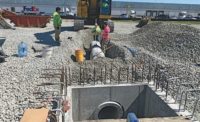Airport Apron Project Using Glass Aggregate Finishes Early

Philadelphia airport apron has the largest application of a recycled aggregate in North America.
Photo courtesy of Philadelphia International Airport
Recycled bottles and glass aggregate helped bring a $31-million overnight parking apron project to substantial completion months ahead of schedule at Philadelphia International Airport in Philadelphia.
The airport, located on the Delaware River, used the recycled aggregate supplied by Aero Aggregates of North America to finish the 58,000-sq-ft overnight parking apron.
Contractor James J. Anderson completed the project, which had a November deadline, in three months instead of nine using ultra-lightweight foamed glass aggregate (ULFGA). The application is the largest of its kind in Northeast America.
“From our records, we know it was the largest job to date in the United States, of 100,000 cubic yards,” says Archie Filshill, the COO with Aero Aggregates.
Filshill says the aggregate is light, so unlike heavy fill dumped after excavating or pile driving, only a small amount of soil is removed before the aggregate is placed. Glass and other materials are put in the kiln to melt and air is injected. The resultant product is similar in appearance and texture to pumice stone.
“We have no new weight added, or zero net surcharges created, and there is no weight on the soil below,” Fishill says. One truckload of aggregate is equivalent to 6 or 7 dump trucks of fill.
“We used one truck instead of six or seven. We reduced the number of trucks coming into the airport by 6,000 trucks,” Filshill adds.
Placing the aggregate required no specialty subcontractor or contractor. “When you place the material it’s an open-ended aggregate, so it goes in in thicker lifts and that makes it go in faster than traditional fill,” Filshill says.
The aggregate is not affected by weather and can be placed even during a rainstorm. Aero Aggregates also is completing a three-phase ramp project using aggregate at Boston Logan International Airport between terminals B and C.
At Philadelphia airport, soil settlement often is an issue because of its river location, says Larry Allen, the airport project manager.
“About all the construction we do, whether it's buildings or aprons, we have to surcharge the material to get a settlement out of it. Historically, we’ve had poor soil conditions with relation to settlement,” Allen says. “We wanted to get this apron constructed as fast as possible with soil conditions and sand, went through geotech analysis, and we determined normal route would add between 6-12 months to the construction duration depending on the rate of settlement."
The project was first proposed in 2017. Philadelphia International Airport had a completion date of 2020 but was hindered by closures during the COVID-19 pandemic.
“We were looking as cutting as much as 12 months but expected 6 to 9 months by going with the lightweight aggregate,” Allen says. “Ultimately, it cut site preparation phase of construction from 9 months down to 3 months.”
He adds that the use of the ULFGA turned the apron work from a 2.5-year project down to about 18 months of construction duration.
Each Aero Aggregates location diverts the equivalent of over 140 million glass bottles per year from landfills and reduces the number of trucks on the road due to the increased volume per delivery.
Allen says Philadelphia airport is one of the first in the region to use UFLGA. The application has been used on Interstate 95 in north Philadelphia.
The material has been used in Europe and Sweden for more than 30 years. Based on studies that have been performed on the material, it has performed well in the long term, Allen says.





